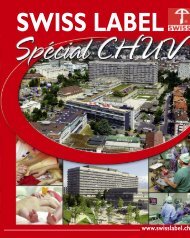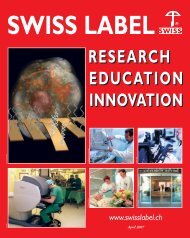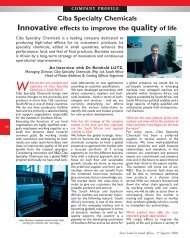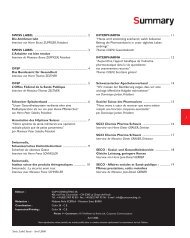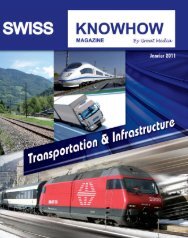swiss label - Com Consulting SA
swiss label - Com Consulting SA
swiss label - Com Consulting SA
Create successful ePaper yourself
Turn your PDF publications into a flip-book with our unique Google optimized e-Paper software.
© CSCS<br />
The newest Cray XT5 computer at CSCS, named “Monte Rosa”, today holds the 21 st position in the prestigious Top500 list,<br />
which ranks the 500 fastest supercomputers worldwide. In Europe Monte Rosa ranks 4 th . There is a good reason for the<br />
brilliant performance: the installation of the Cray XT5 is the first step in the implementation of the national strategy for<br />
high-performance computing and networking (HPCN) proposed in 2007 by a group of experts, and launched in 2009 by the<br />
Swiss Federal Council.<br />
Supercomputers are the fastest and most powerful computers<br />
available. They are increasingly used in the fast-growing field of<br />
computational sciences. They are made up of tens or hundreds<br />
of thousands of single processors, which operate in parallel as a single<br />
big machine thanks to a sophisticated, high-speed communication<br />
network. Because of their structure, they are called massively parallel<br />
computers. The performance of such machines is expressed by the<br />
number of floating point operations per second (flops) they are able to<br />
perform. Monte Rosa’s computing speed is ten thousand times faster<br />
than that of a latest-generation PC. It is however, only one tenth as<br />
fast as that of the winner of the latest Top500 contest, the Cray XT5<br />
“Jaguar” of the Oak Ridge National Laboratory in Tennessee.<br />
CSCS installed its first massively parallel supercomputer only a few<br />
years ago, in 2005. Il was a Cray XT3 machine, the first of this kind<br />
in Europe, and a wise investment that proved to be decisive for the<br />
future strategy of the Centre. A Cray XT4 used by the national<br />
weather forecasting service MeteoSwiss, and the newly installed Cray<br />
XT5 continue this successful line. Monte Rosa is made up of 20 cabinets<br />
containing around fifteen thousand processors linked by means of a<br />
newly designed high-speed network. A novel, highly efficient watercooling<br />
system has replaced the air-cooling used in former models.<br />
Supercomputers play a key role in science today as they enable the<br />
researchers using numerical simulation techniques to tackle arduous<br />
problems and to study complex systems, which would otherwise not<br />
be accessible to scientific analysis. This methodology is recognized as<br />
Swiss Label Ticino 2010<br />
C O M PA N Y P RO F I L E<br />
New developments at CSCS,<br />
the national supercomputing centre<br />
the third pillar of scientific research alongside theory and experiment.<br />
Supercomputing offers extraordinary opportunities: it allows scientists<br />
to represent and thus to study the movement of single atoms in a<br />
molecule, the diffusion of drugs or other chemical substances through<br />
biological membranes, the adhesion and proliferation of bacteria in<br />
tissues, the penetration of a virus into a cell, which is the initial phase<br />
of an infection, and many more phenomena in areas such as physics,<br />
chemistry, climate and astronomy which cannot be explored by means<br />
of experiments. In the fields of engineering, medicine, technology and<br />
many more, simulation is increasingly substituting experiments and<br />
there is even hope that supercomputing may eventually reduce the<br />
need for animal experimentation in the pharmaceutical industry.<br />
In order to implement the Swiss national strategy for highperformance<br />
computing, a supercomputer of the petaflops class is to<br />
be installed at CSCS in 2012. This system will be housed in a new<br />
CSCS building in Lugano, which will also provide the space and the<br />
power for future machines. The strategy also intends to strengthen the<br />
national network between universities and boost education in the field<br />
of computational sciences. The faculty of informatics of the University<br />
of Lugano (USI), recognized for its excellence, has made a first important<br />
step in this direction, together with CSCS, by laying the basis for a<br />
centre of competence that will also include ETH Zurich. CSCS also<br />
aims at working closely with the other Swiss universities and industry<br />
to develop the supercomputing architectures of the future. Another<br />
ambitious objective is to eventually create a Swiss supercomputing<br />
ecosystem by coordinating the use of local resources at the universities<br />
and of national resources at CSCS in order to<br />
ensure optimal accessibility in accordance with the<br />
type of applications and best exploit the enormous<br />
opportunities offered by computational sciences.<br />
Marco Baggiolini, former acting director of CSCS<br />
Swiss National Supercomputing Centre<br />
Galleria 2, Via Cantonale<br />
CH-6928 Manno (Switzerland)<br />
25



